
Posted: 5/1/2019 | May 1st, 2019
Cambodia: it’s full of warm and friendly people, beautiful coastlines, and lively nightlife, and it has a growing foodie scene. It’s also one of the cheapest countries in the world.
I didn’t have high expectations when I first visited in 2006. Back then, all I knew about Cambodia was its awful history involving the Khmer Rouge and that it was home to Angkor Wat.
But I was blown away by the people and their warmth, spirit, and hospitality; the beautiful natural scenery; and the country’s long history. It was wonderful, and I ended up staying weeks longer than I thought I would (I especially loved Phnom Penh). I returned often, including spending over a month there when I was writing my first book. (It made for a great base of operations.)
In the last decade or so, Cambodia has grown by leaps and bounds. Sleepy little towns I visited before are now megacities, tourists (especially Russians and Chinese) visit en masse, there are more ATMs (there was exactly one in the country when I first went), and there’s a growing expat and foodie scene.
Cambodia still has problems, but it’s a lot more cosmopolitan today than when I first went.
What should you do when you visit Cambodia?
How should you plan your trip?
Below are some itineraries that include the best destinations in Cambodia. You can use them as a guideline to help you make the most of your trip!
What to See and Do in Cambodia: A One-Week Itinerary
Day 1 – Phnom Penh
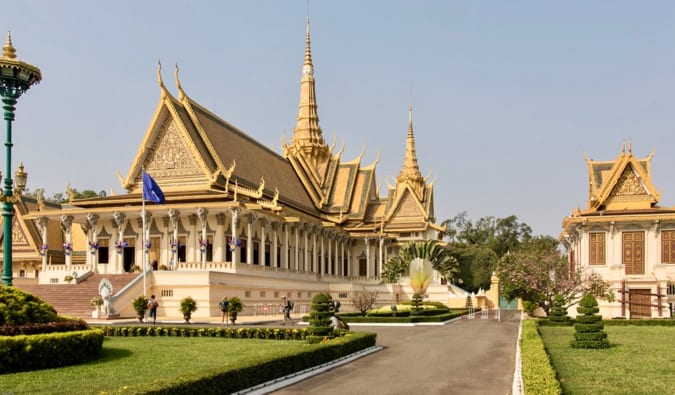
The capital of Cambodia, Phnom Penh has a Wild West ambiance, with dusty streets and a “devil may care” atmosphere. It has a few good attractions and an up-and-coming foodie scene.
The main attraction is the Royal Palace. Start there, and don’t miss the beautiful flower gardens and the Silver Pagoda, whose floor is made up of more than 5,000 silver tiles; inside is an emerald-covered Buddha and a diamond-covered Maitreya Buddha. It also has murals around its outer wall that tell the story of the Ramayana.
On the palace grounds are five stupas, with the two largest to the east containing the ashes of King Norodom and King Udung (the two most famous kings of modern Cambodia) and a statue of King Norodom on horseback. Admission is $10 USD for foreigners.
After seeing the palace, learn about the country’s tragic, not-too-distant history. The Tuol Sleng Genocide Museum is a former school where the Khmer Rouge interrogated and tortured people in the 1970s. You’ll see rusty beds and torture devices, in sharp contrast to the beautiful trees and lovely jasmine smell in the gardens. Admission is $5 USD for adults and $3 USD for anyone under 18.
Afterward, head to the Killing Fields, about 14km from Tuol Sleng. Although a visit to Choeung Ek (the best-known site) may not be the most cheerful way to spend an afternoon, it makes for a hallowed and memorable experience, a testament to the dangers of uncontested power. You won’t believe the memorial building in the center that is filled with skulls. Admission is only $3 USD; expect to pay at least $15 USD for a return-trip tuk-tuk ride.
(Tip: Visit the museum before heading to the Killing Fields, as it will open your eyes to the atrocities that happened here.)
Where to Stay in Phnom Penh: Sla Boutique Hostel – This is a pretty nice hostel not far from restaurants, bars, and attractions. It’s clean, and the beds are comfy and have privacy curtains. The staff (especially Mr. Star) are super friendly, and they can really help you plan your trip.
Day 2 – Phnom Penh
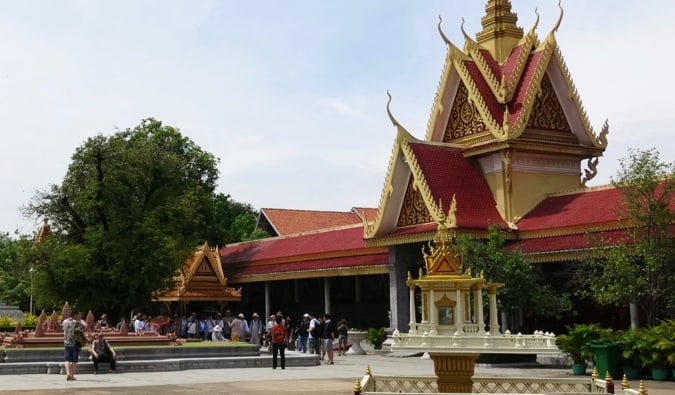
Spend your second day wandering around the city, and start by seeing the Independence Monument, designed by architect Vann Molyvann and inaugurated in 1958. It was created to mark Cambodia’s independence from French rule, though it also serves as a de facto war memorial. It’s one of the biggest landmarks in the city and a good place to start your day.
If you’re in the city on a weekend, try to catch an architectural walking tour with KA Tours, which has excellent guides who are students or experts in architecture, plus they’re not very expensive, around $15.
Check out the Cambodian Living Arts Center, a traditional dance school and performance center where you can watch students in training and see traditional live theatre. This is a fun way to spend a couple of hours while learning about the artistic traditions of the country. You can also take part in a workshop, which last around 90 minutes and cost $15 USD per person.
Make sure you stroll along Sisowath Quay on the Mekong River. The 3km walkway is busy and full of restaurants, bars, cafés, and shops.
Day 3 – Sihanoukville
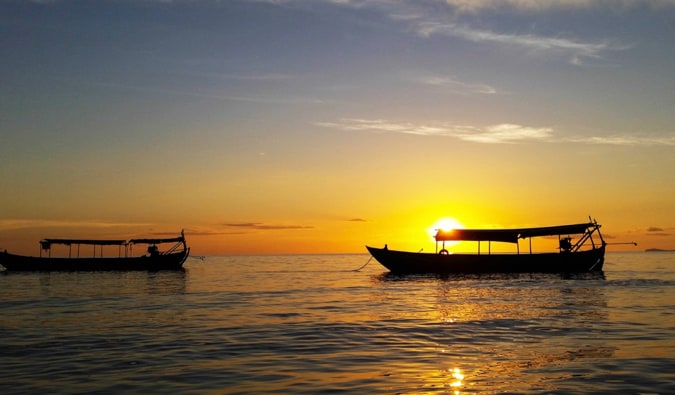
Get an early start and take a five-hour bus ride to Sihanoukville, named after the ruling prince of Cambodia in 1964. It was a lazy beach town until about 2010, when it took off with travelers (and tons of Chinese and Russian tourists on package tours) because of its white-sand beaches, nearby deserted islands, excellent diving, and delicious seafood. Its varied nightlife filled with cheap booze makes it the premier backpacker party city in Cambodia.
If you’re looking to soak up some sun, Independence Beach and Otres Beach are probably your best bets. Serendipity Beach used to be a great party spot, but there’s a lot of Chinese development going on now, so I wouldn’t stay there.
Where to Stay in Sihanoukville: Monkey Republic – This hostel is awesome. It’s a happening place, with a bar, restaurant, and pool. The staff is really friendly, and they host a lot of events. (Say hi to Aaron for me!) They can also organize a lot of day trips for you too.
Day 4 – Sihanoukville
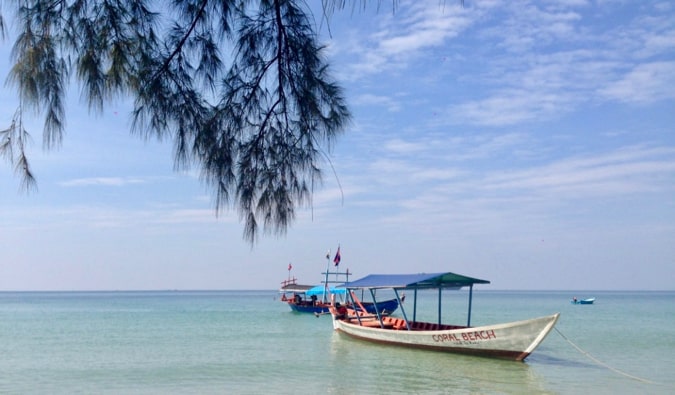
Today is a day for day trips.
From Sihanoukville, hop on a boat and take a 45-minute ride to Koh Rong. While you can stay overnight, if you’re pressed for time, you can do it in a day trip. The beaches here are way better than on the mainland (and a lot less polluted). Snorkeling day trips cost approximately $21 USD and include lunch and equipment; there are PADI-certified schools in the area that offer a variety of different dive trips for one or more days.
If you don’t feel like heading to Koh Rong, you could book motorbike trip into Bokor National Park (as well as longer, multiday trips if you’re interested). There, you can hike through a great rainforest or see the atmospheric ruins of the French aristocracy for whom Bokor was a big draw back in the day. You’ll have some amazing views and find ruins, waterfalls, and temples all around.
You could also do a day trip to Kampot and the pepper fields in that area too.
Day 5 – Siem Reap
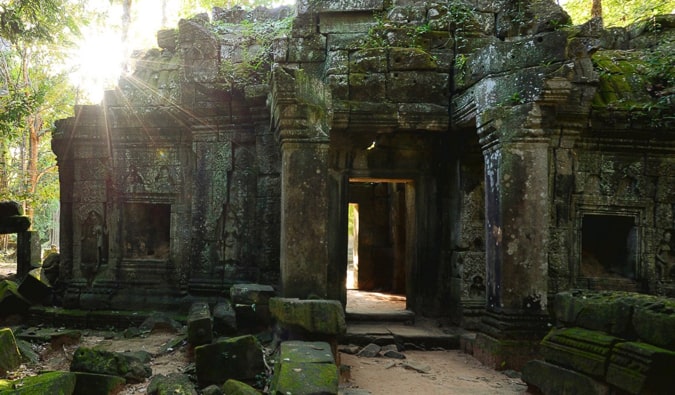
It’s gonna be a busy travel day. From Sihanoukville, you’ll need to return to Phnom Penh and then get on another bus to Siem Reap. I recommend Capitol Tours. It’s a 12-hour ride, so it’ll be evening by the time you get to Siem Reap.
(Note: It’s better to take the night bus so as not to waste a day. You won’t sleep well, but you also won’t lose a day!)
Siem Reap is located on the northeastern side of Tonle Sap Lake and is the main access to Angkor Wat. The center remains a rural old town, with French-style houses and shops. The area around the Old Market is crowded with locals and foreigners all day long.
Where to Stay in Siem Reap: Topsky Hostel – This hostel offers basic accommodations in a pretty quiet area that’s not far from the action. Try to get a lower bunk with a privacy curtain. The friendly staff will help you arrange a tuk-tuk and activities too.
Day 6 – Siem Reap
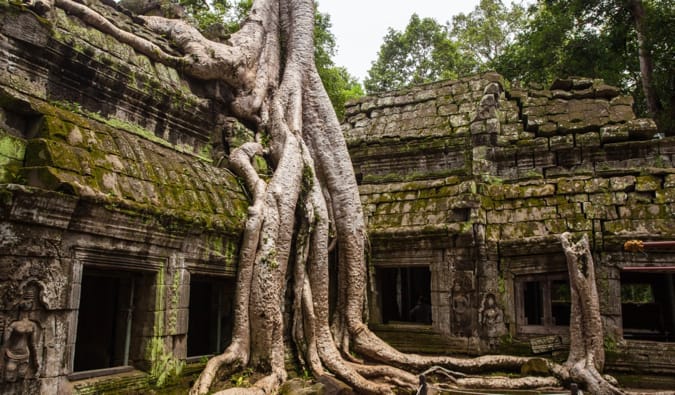
Spend your day at Angkor Wat, the ancient city that was the center of the Khmer Empire that once ruled most of Southeast Asia. The temple was built in the 12th century and covers over 500 acres.
The most popular temples are Angkor Wat, Bayon, Ta Phrom, and Angkor Thom. I would recommend getting a multiday pass so you can visit some of the outer temples where there are fewer visitors. You can hire a tuk-tuk for the day for around $20-25 USD or rent bicycles and explore on your own.
Angkor Wat is open daily from 5am to 6pm. Admission is $37 USD per person for a day pass, $62 USD for a three-day pass, and $72 USD for a seven-day pass.
Day 7 – Siem Reap
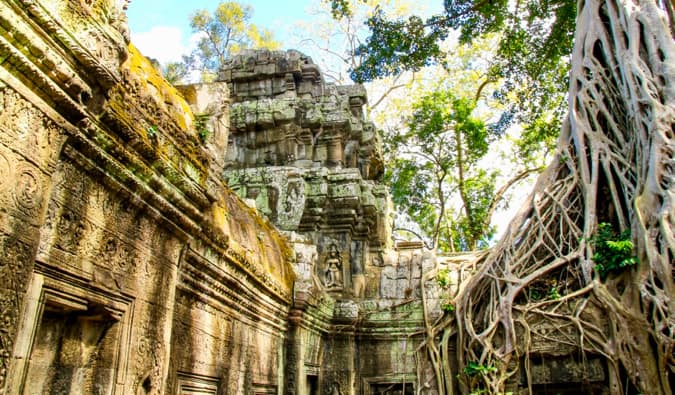
Enjoy your last day in Cambodia by exploring more of the Siem Reap area. Head over to the Angkor Wat complex for several more hours in the morning and then head over to astonishing Banteay Srei.
Known as “the city of women,” this temple was dedicated to the Hindu god Shiva and features a number of outstanding red sandstone statues. (You need an Angkor Wat Pass to visit.)
If you have time, visit Tonle Sap, Southeast Asia’s largest freshwater lake. It is 52km (32 miles) from Siem Reap. Sailing down the river and around the lake gives you a look at how closely Cambodian life is tied to this major waterway. Tours start around $2.50 USD per person.
What to See and Do in Cambodia: A Two-Week itinerary
Want to spend more time in Cambodia? Great! You should! There are tons of other places to visit. Here are my suggestions:
Days 1 & 2 – Phnom Penh
Follow the Phnom Penh itinerary from above.
Day 3 & 4 – Sihanoukville
Follow the Sihanoukville itinerary from above.
Day 5 & 6 – Koh Rong

Head out to Koh Rong, which got its name after the legend of a giant King Kong–like ape that once called the island home. It’s a 45-minute trip from Sihanoukville and a great place to relax on the beach or go snorkeling. There are a lot of accommodation options, and it’s a popular spot with backpackers.
Day trips costs around $25 USD and include lunch and snorkeling equipment, but since you have the time, spend a few nights here relaxing and enjoying beach life.
There are also other islands nearby if you want to stay longer and explore, including Koh Rong Samloem, which is becoming something of a backpacker paradise (there’s even a Full Moon Party there now).
Days 7 & 8 – Kep

In the morning, travel by bus to Kep, which is about two hours from Sihanoukville. This quaint beach town and fishing village is the quiet version of Sihanoukville: a nice place to relax near the ocean but without a party atmosphere. It’s famous for its pepper crab and empty beaches.
Consider taking two full days here. Sure, it’s quite sleepy and there’s not a lot to do, but it’s the perfect place to relax, eat all the delicious crabs the city is famous for, and read a book. You can also spend some time on nearby Rabbit Island (Koh Tonsay) too, a secluded and charming escape from the world if you’re looking to disconnect. Basic bungalows can be rented for under $10 USD per night.
Where to Stay in Kep: Khmer House Hostel – Kep is pretty spread out, so wherever you stay, make sure you rent a bike or scooter. This hostel is a good option as it’s not far from the Crab Market.
Day 9 – Kampot
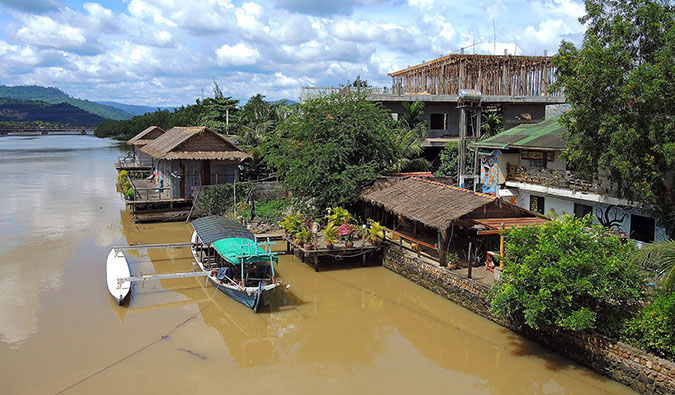
The southern region of Cambodia is filled with pepper farms where you can learn about the history of the spice, see how it is grown, and pick up what is considered some of the finest pepper in the world.
I’d spend one night in Kampot. It’s another quiet town on the coast. Most people come here to enjoy the scenic riverside views as well as the rolling hills that surround the city. The area used to be a getaway for the French, so you’ll see old French architecture around.
At night, the street near the old bridge is lined with fruit shake vendors. Try a million. The city is famous for them.
Also, if you only do one thing in this entire itinerary, make sure it’s eating the ribs at The Rusty Keyhole. They are some of the best ribs I’ve ever had in my entire life. You have to order them the day before. You’ll also get healthy side of mashed potatoes and coleslaw too. It’s one of the best meals I’ve ever had. I still dream of it.
Where to Stay in Kampot: The Magic Sponge – This is one of my favorite hostels in Cambodia. Make sure you book early, as it tends to sell out. It’s a really nice, relaxed guesthouse where you’ll get your own bed (not a bunk). You’ll feel at home here, and it’s a short walk to the center of town. The dorm rooms are very clean. They also have a little mini-golf course too.
Day 10 – Kampot
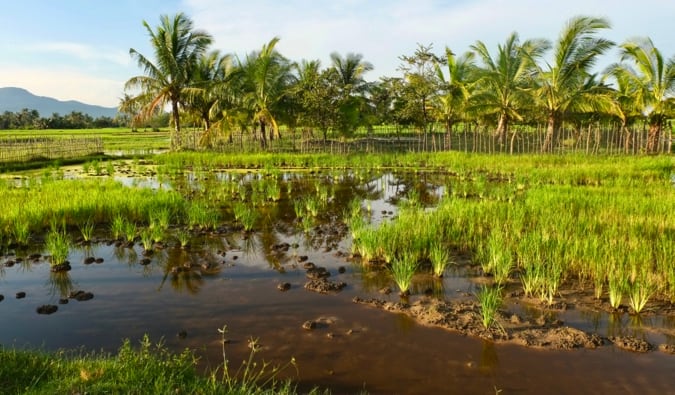
Today, hire hire a tuk-tuk driver to explore the Kampot area. The Phnom Chhngok Cave Temple has a religious shrine inside, or you can head out and spend the day in Bokor, as Kampot is relatively close to the park.
Days 11, 12, & 13 – Siem Reap
Follow the Siem Reap itinerary from above. Angkor Wat is best seen slowly, so use your days to explore it as much as possible. There are a lot of out-of-the-way temples to visit that are free of crowds.
Day 14 – Siem Reap

On your last day in Cambodia, why not take a cooking class? The class sizes tend to be around six people, and you will learn to prepare three different meals, as well as get recipe cards at the end. Prices start around $20 USD per person; local guesthouses can help arrange a class.
What to See and Do in Cambodia: A Three-Week Itinerary
Have even more time for Cambodia? Good! Cambodia has a lot more to it than the major spots on the backpacker trail.
Days 1, 2, & 3 – Phnom Penh and Kirirom National Park
Follow the above suggestions, but also head out to Kirirom National Park for a day trip. This park has all sorts of walking trails, mountain biking trails, waterfalls, and a few lakes. It’s a good place to go to take a break from the city.
The park is around a two-hour drive from the city, so you’ll need to hire a driver for the day. The best way to do this is to find some travelers to join you so you can share a ride, which will cost around $80 for the day.
Days 4, 5, 6, 7, & 8 – Sihanoukville and the Islands
Follow the above suggestions but at a much slower pace!
Days 9, 10 & 11 – Kep and Rabbit Island
Follow the above suggestions for Kep, but head out to Rabbit Island for a rustic island getaway.
Days 12 & 13 – Kampot
Follow the above suggestions!
Days 14, 15, & 16 – Siem Reap
Follow the above suggestions!
Day 17 – Koh Ker

For a fun day trip from Siem Reap, head to Koh Ker, located around 2.5 hours from town. Koh Ker was briefly the capital of the Khmer Empire, and many of the temples here are over 1,000 years old. It’s a massive archeological site located in the jungle, and it sees far fewer tourists than Siem Reap.
There are no public buses that go there (the roads were only paved a few years ago), so you’ll have to arrange transportation via your hostel or hotel.
Day 18 – Phnom Kulen

For another fun day trip, head to Phnom Kulen, considered the country’s most sacred mountain. It’s located just 50km from Siem Reap and offers some amazing jungles, hiking, and picturesque waterfalls where you can take dip to beat the heat. You can easily spend a day here. If you head up to the summit, there are some great views as well as a large reclining Buddha statue. Try to arrive early as the park fills up by lunchtime. Admission to the park is $20 USD.
Day 19 – Battambang

From Siem Reap, you can take a three-hour bus to Battambang. Or try taking a riverboat on Tonle Sap for a unique experience (there is one boat per day, with tickets costing around $20 USD per person).
When you arrive, you’ll discover Cambodia without the tourism. Get familiar with Battambang by exploring the town on foot (or by tuk-tuk). Check out the Phsar Boeung Choeuk and Phsar Naht markets. You’ll also want to visit the gorgeous pagodas and temples, such as Wat Pippitharam (near the Old Market), Wat Bovil, Wat Kandal, and Wat Damreay Sar.
In the evening, check out the Battambang Circus. The show is put on by students at a Cambodian nonprofit arts school, so your donations go to a good cause.
Where to Stay in Battambang: Sophea Hostel – This is a good place to meet locals and make some friends. It’s family-run, and they try to make you feel at home. The facilities are pretty basic, but typical, dorms. There’s a nice garden and sitting area. While there’s no restaurant on-site, there are plenty of nearby options.
Day 20 – Battambang
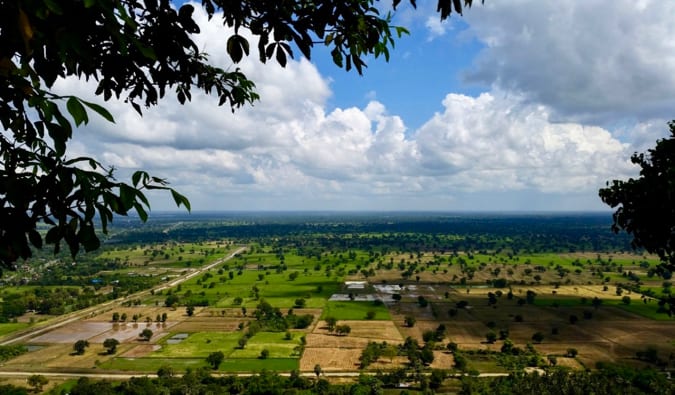
Take it easy this morning by touring the town a bit more on foot. Check out the colonial architecture along the waterfront and the governor’s residence. This building from the early 1900s is not open, but you can marvel at the exterior.
While you’re wandering, don’t miss the Art Deco central market building and the Victory swimming pool (where you can take a dip if you’re in the mood). You may want to visit the Battambang Museum; admission is just $1 USD, and you’ll learn a lot about the history of the area.
After lunch, you should grab a tuk-tuk and head a bit out of town to check out Phnom Sampeu. Take about an hour to climb to the monastery on the hill. You’ll also find some caves in the area with Buddhist temples in them. There’s also another cave at the foot of Phnom Sampeu; this is where you want to be around dusk, when millions of bats fly out of the cave in search of food. It’s an incredible sight!
Day 21 – Siem Reap or Phnom Penh
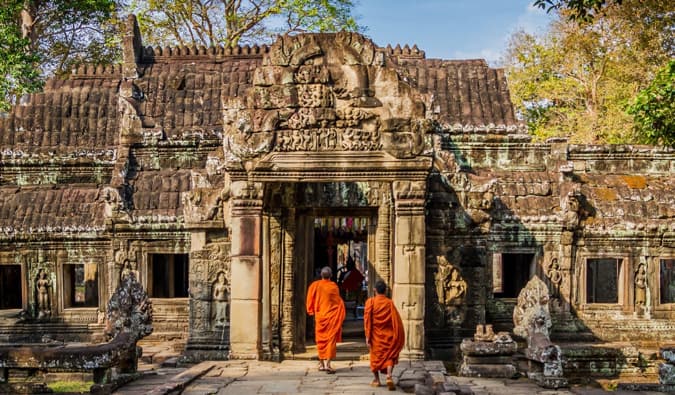
Make your way back to one of these towns, depending on where your flight is leaving from. Enjoy the bus ride, knowing it’s your last in Cambodia (at least for now)!
I always love my time in Cambodia. It lacks the polish of Thailand, making travel here a little more rustic and challenging.
But more amazing than any of the country’s sights and activities are the people. I’ve always found them to be incredibly welcoming. Even with so much darkness clouding their recent history, Cambodians always go above and beyond, making any trip here a memorable one.
But don’t take my word for it. Come and see this incredibly country for yourself.
And let these suggested Cambodia itineraries help you plan your trip!
Book Your Trip to Cambodia: Logistical Tips and Tricks
Book Your Flight
Find a cheap flight by using Skyscanner or Momondo. They are my two favorite search engines because they search websites and airlines around the globe, so you always know no stone is being left unturned.
Book Your Accommodation
You can book your hostel with Hostelworld. If you want to stay somewhere other than a hostel, use Booking.com as they consistently return the cheapest rates for guesthouses and cheap hotels. I use them all the time. My favorite places to stay are:
- Sla Boutique Hostel (Phnom Penh) – This is a classy hostel not far from restaurants, bars, and attractions. It’s clean, and the beds are really comfy!
- Topsky Hostel (Siem Reap) – This hostel is in a quiet area and offers basic accommodation. The staff will help you arrange a tuk-tuk and activities.
Don’t Forget Travel Insurance
Travel insurance will protect you against illness, injury, theft, and cancellations. It’s comprehensive protection in case anything goes wrong. I never go on a trip without it, as I’ve had to use it many times in the past. I’ve been using World Nomads for ten years. My favorite companies that offer the best service and value are:
- World Nomads (for everyone below 70)
- Insure My Trip (for those over 70)
Looking for the best companies to save money with?
Check out my resource page for the best companies to use when you travel! I list all those I use to save money, and I think they will help you too!
Want More Information on Cambodia?
Be sure to visit our robust destination guide on Cambodia for even more planning tips!
The post Backpacking Cambodia: 3 Suggested Itineraries for Your Trip appeared first on Nomadic Matt's Travel Site.
May 01, 2019 at 12:30PM
fom http://bit.ly/2vx5JUk
by IHholiday Travel trip
No hay comentarios:
Publicar un comentario